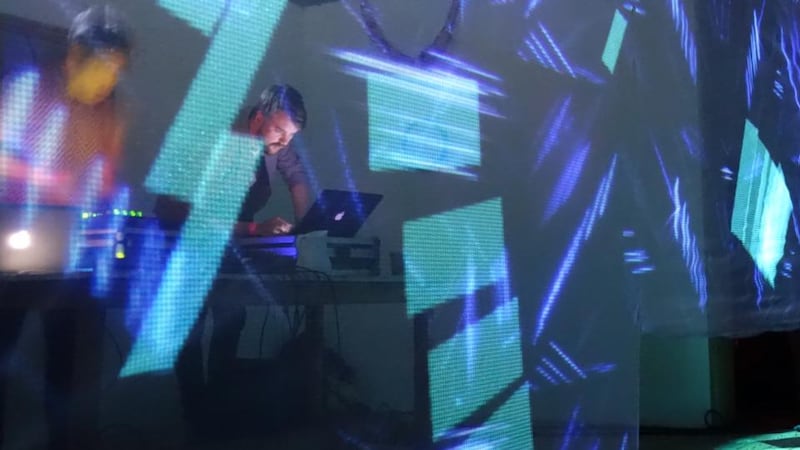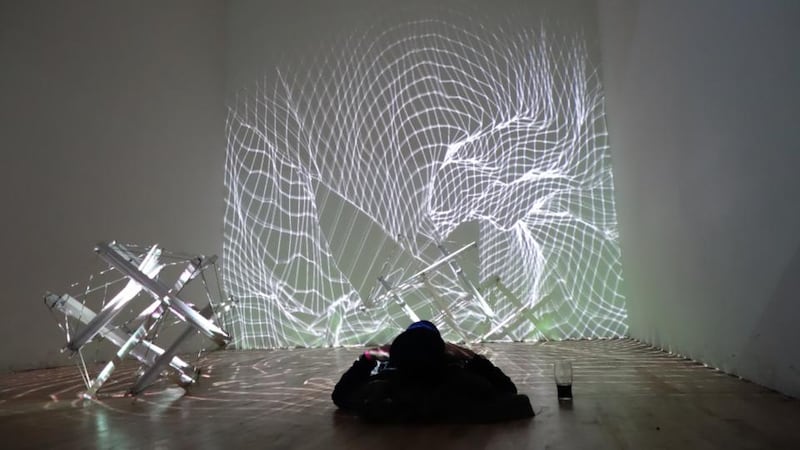'Art has a value and a power in wild places," says artist Luke Franklin of 4 Bothies, during one of the talks at this year's Drop Everything on Inisheer. This "art project about adventure" put four art shelters – a gallery, a study, a studio and a gallery – in four remote corners of the country.
It’s a neat synecdoche for Drop Everything, which is a biennial cultural event. It takes place on one of the wildest places in Europe, where Ireland’s four seasons feel like they could drop in a day, on an Aran Island that hums with possibility.
Drop Everything is a synthesis of old and new, location and event. After arriving by ferry or on a thrilling eight-minute flight from the mainland, patrons stroll into the village or catch a lift on horse and cart. The island has been taken over by a benevolent invasion. Song lyrics flutter cheerfully in the breeze – "I want to dance with somebody" – writ large by Lukas Julius Keijser, on sheets hung on clothes lines. Colourful messages of hope and humour – "Everything is beautiful and nothing hurts" – line the roads.


On the village's main beach, HyBrasil's Newfoundlight takes shape, blooming to full colour on Saturday night, a series of light poles swelling and pulsing in complement to rich harmonies that shimmer out from the dunes. On the far side of the island, the installation Skyhenge carries an echo of Glastonbury, using meagre, scavenged materials to point out celestial bodies and stars in the glittering sky. It's hampered by weather, but the scramble to find it is an adventure worthy of the trip alone.
Blurred lines
A handball alley is transformed by Sougwen Chung in her haunting sculptural audio-visual work Ecdysis. At times, the lines are blurred, and anything seems possible: could Drop Everything have sunk an ancient church 6ft into the graveyard? It's been here for about 1,000 years, though, dedicated to Caomhán, who is buried next to it.
Grace Dyas and Martin Sharry have set up a tea shop in a home built by Sharry's great grandfather. It is filled with clothing rails packed with work by his mother. Up the road, Galway's Ard Bia restaurant takes over the local Teach an Tae, to serve an island's worth of people on Saturday evening. On Sunday morning, Dublin's Fumbally cafe pitches up on the rocks, and serves a breakfast brunch cooked overnight in a fulacht fiadh. Tigh Ruairí gives over one of its bars to host special island-inspired cocktails. All the talk is of whose bean an tí serves the best baked bread, or who got the nicest breakfast.
The beauty of this event and what makes it unique is its setting in a weird and wonderful place, and everyone is trusted to be responsible. There are no high-vis jackets, and the printed programme says that “if you see anyone acting the maggot, tell them to check themselves. Consider where you are right now. Make lifelong friends and please don’t litter. Scaoil amach é.”
Drop Everything is entirely crowd-focused, having raised more than €2,000 over its crowd-funded target of €16,000. More than 300 make the trip, and each funder is given a wristband, but it's barely necessary. This is a festival with an open-door policy, and everything is free for the islanders. The artists and volunteers all work for free, including the two Galway forces of nature who make the whole thing happen: Mary Nally and Síomha Nee.
Most of the main events take place in the Arts Centre, reached by a winding stone-walled road. The place is packed throughout, from Lelia Doolan's stirring opening speech, to the 4 Bothies brilliant bit of inspiration. The work of photographer Rich Gilligan hangs on the walls, unlovely bits of urban grit telling their own stories in this most rural of settings. Actor Hugh O'Conor interviews designer Annie Atkins, taking a tour through the almost terrifying level of detail in her work on The Grand Budapest Hotel. Emerging artists get a look in too, with singer Somerville a particular, haunting highlight.
Late nights in town
Back in town, things take off late at night, with each of the island's three bars taking turns to host the main evening sessions. Things kick off in the Hall Scoile, with Clu's pinpoint projections and music transforming a functional building. On the opening night, Sally Cinnamon and This Greedy Pig turn the back room of Tigh Ruairí into a sea of uplifted arms and colour. On Saturday, it's the Óstán's turn, with a quartet of White Collar Boy, Colm Finnegan, New Jackson and Colm K tipping the tunes until the small hours. The evening ends in the early morning, with most soaking up the beach's glorious sunrise.
The final night has the air of something altogether magical. The white beaches and tropical-coloured water are made more tempting by a balmy day of sun. At Tigh Ned's, Padraic Disconaut and Tim Donovan spin through several stunning sets in the bar's front garden, while everyone dances with the shimmering Atlantic for company. Neil Watkins of Buffalo Woman performs with typical humour and aplomb; never has a tabletop stage seemed larger. Inside the bar, a session is in full flow, led by David Kitt and Silla from Icelandic band Múm.
The fun only stops for a few moments when the entire party slips down to the rocks to watch the sun burn out the last few minutes, turning the sea wine dark in an extraordinary almost-final festival effort.
Sun, sea and stars; music, art and madness. An island transformed, to bring out its best, and you leave the crowd with what feels like a month of memories. Two years seems too long to wait for the next one.












